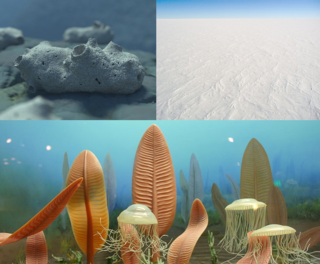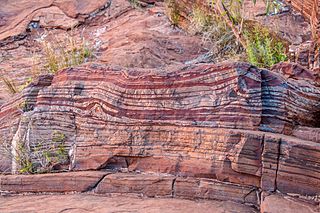Related Research Articles

The Ediacaran period is a geological period of the Neoproterozoic era that spans 96 million years from the end of the Cryogenian period at 635 Mya, to the beginning of the Cambrian period at 538.8 Mya. It is the last period of the Proterozoic eon as well as the last of the so-called "Precambrian supereon", before the beginning of the subsequent Cambrian period marks the start of the Phanerozoic eon where recognizable fossil evidence of life becomes common.

The Neoproterozoic Era is the unit of geologic time from 1 billion to 538.8 million years ago.

The Snowball Earth is a geohistorical hypothesis that proposes during one or more of Earth's icehouse climates, the planet's surface became entirely or nearly entirely frozen with no liquid oceanic or surface water exposed to the atmosphere. The most academically referred period of such global glaciation is believed to have occurred sometime before 650 mya during the Cryogenian period.

Paleoclimatology is the scientific study of climates predating the invention of meteorological instruments, when no direct measurement data were available. As instrumental records only span a tiny part of Earth's history, the reconstruction of ancient climate is important to understand natural variation and the evolution of the current climate.

Banded iron formations are distinctive units of sedimentary rock consisting of alternating layers of iron oxides and iron-poor chert. They can be up to several hundred meters in thickness and extend laterally for several hundred kilometers. Almost all of these formations are of Precambrian age and are thought to record the oxygenation of the Earth's oceans. Some of the Earth's oldest rock formations, which formed about 3,700 million years ago (Ma), are associated with banded iron formations.

The Proterozoic is the third of the four geologic eons of Earth's history, spanning the time interval from 2500 to 538.8 Mya, the longest eon of the Earth's geologic time scale. It is preceded by the Archean and followed by the Phanerozoic, and is the most recent part of the Precambrian "supereon".

The Cryogenian is a geologic period that lasted from 720 to 635 million years ago. It forms the second geologic period of the Neoproterozoic Era, preceded by the Tonian Period and followed by the Ediacaran.
The geologic temperature record are changes in Earth's environment as determined from geologic evidence on multi-million to billion (109) year time scales. The study of past temperatures provides an important paleoenvironmental insight because it is a component of the climate and oceanography of the time.

The Varanger Peninsula is a peninsula in Finnmark county, Norway. It is located in the northeasternmost part of Norway, along the Barents Sea. The peninsula has the Tanafjorden to the west, the Varangerfjorden to the south, and the Barents Sea to the north and east. The municipalities of Vadsø, Båtsfjord, Berlevåg, Vardø, Tana, and Nesseby share the 2,069-square-kilometre (799 sq mi) peninsula. Nesseby and Tana are only partially on the peninsula, with the rest being entirely on the peninsula. The Varangerhalvøya National Park protects most of the land on the peninsula.

The important sulfur cycle is a biogeochemical cycle in which the sulfur moves between rocks, waterways and living systems. It is important in geology as it affects many minerals and in life because sulfur is an essential element (CHNOPS), being a constituent of many proteins and cofactors, and sulfur compounds can be used as oxidants or reductants in microbial respiration. The global sulfur cycle involves the transformations of sulfur species through different oxidation states, which play an important role in both geological and biological processes. Steps of the sulfur cycle are:
The Huronian glaciation was a period where at least 3 ice ages occurred during the deposition of Huronian Supergroup. Deposition of this largely sedimentary succession extended from approximately 2.5 to 2.2 billion years ago (Gya), during the Siderian and Rhyacian periods of the Paleoproterozoic era. Evidence for glaciation is mainly based on the recognition of diamictite, that is interpreted to be of glacial origin. Deposition of the Huronian succession is interpreted to have occurred within a rift basin that evolved into a largely marine passive margin setting. The glacial diamictite deposits within the Huronian are on par in thickness with Quaternary analogs.

The Great Oxidation Event (GOE) or Great Oxygenation Event, also called the Oxygen Catastrophe, Oxygen Revolution, Oxygen Crisis or Oxygen Holocaust, was a time interval during the Early Earth's Paleoproterozoic era when the Earth's atmosphere and the shallow ocean first experienced a rise in the concentration of oxygen. This began approximately 2.460–2.426 Ga (billion years) ago during the Siderian period and ended approximately 2.060 Ga ago during the Rhyacian. Geological, isotopic, and chemical evidence suggests that biologically produced molecular oxygen (dioxygen or O2) started to accumulate in Earth's atmosphere and changed it from a weakly reducing atmosphere practically devoid of oxygen into an oxidizing one containing abundant free oxygen, with oxygen levels being as high as 10% of their present atmospheric level by the end of the GOE.

The clathrate gun hypothesis is a proposed explanation for the periods of rapid warming during the Quaternary. The hypothesis is that changes in fluxes in upper intermediate waters in the ocean caused temperature fluctuations that alternately accumulated and occasionally released methane clathrate on upper continental slopes. This would have had an immediate impact on the global temperature, as methane is a much more powerful greenhouse gas than carbon dioxide. Despite its atmospheric lifetime of around 12 years, methane's global warming potential is 72 times greater than that of carbon dioxide over 20 years, and 25 times over 100 years. It is further proposed that these warming events caused the Bond Cycles and individual interstadial events, such as the Dansgaard–Oeschger interstadials.
Throughout Earth's climate history (Paleoclimate) its climate has fluctuated between two primary states: greenhouse and icehouse Earth. Both climate states last for millions of years and should not be confused with glacial and interglacial periods, which occur as alternate phases within an icehouse period and tend to last less than 1 million years. There are five known Icehouse periods in Earth's climate history, which are known as the Huronian, Cryogenian, Andean-Saharan, Late Paleozoic, and Late Cenozoic glaciations. The main factors involved in changes of the paleoclimate are believed to be the concentration of atmospheric carbon dioxide, changes in Earth's orbit, long-term changes in the solar constant, and oceanic and orogenic changes from tectonic plate dynamics. Greenhouse and icehouse periods have played key roles in the evolution of life on Earth by directly and indirectly forcing biotic adaptation and turnover at various spatial scales across time.
The Marinoan glaciation, sometimes also known as the Varanger glaciation, was a period of worldwide glaciation. Its beginning is poorly constrained, but occurred no earlier than 654.5 Ma. It ended approximately 632.3 ± 5.9 Ma during the Cryogenian period. This glaciation possibly covered the entire planet, in an event called the Snowball Earth. The end of the glaciation was caused by volcanic release of carbon dioxide and dissolution of gas hydrates and might have been hastened by the release of methane from equatorial permafrost.
The Medea hypothesis is a term coined by paleontologist Peter Ward for a hypothesis that contests the Gaian hypothesis and proposes that multicellular life, understood as a superorganism, may be self-destructive or suicidal. The metaphor refers to the mythological Medea, who kills her own children.
The Boring Billion, otherwise known as the Mid Proterozoic and Earth's Middle Ages, is the time period between 1.8 and 0.8 billion years ago (Ga) spanning the middle Proterozoic eon, characterized by more or less tectonic stability, climatic stasis, and slow biological evolution. It is bordered by two different oxygenation and glacial events, but the Boring Billion itself had very low oxygen levels and no evidence of glaciation.
Deglaciation is the transition from full glacial conditions during ice ages, to warm interglacials, characterized by global warming and sea level rise due to change in continental ice volume. Thus, it refers to the retreat of a glacier, an ice sheet or frozen surface layer, and the resulting exposure of the Earth's surface. The decline of the cryosphere due to ablation can occur on any scale from global to localized to a particular glacier. After the Last Glacial Maximum, the last deglaciation begun, which lasted until the early Holocene. Around much of Earth, deglaciation during the last 100 years has been accelerating as a result of climate change, partly brought on by anthropogenic changes to greenhouse gases.
The Neoproterozoic Oxygenation Event (NOE), also called the Second Great Oxidation Event, was a time interval between around 850 and 540 million years ago which saw a very significant increase in oxygen levels in Earth's atmosphere and oceans. Bringing an end to the Boring Billion, a period of extremely low atmospheric oxygen spanning from the Statherian to the Tonian, the NOE was the second major increase in atmospheric and oceanic oxygen concentration on Earth, though it was not as major as the Great Oxidation Event (GOE) of the Neoarchean-Paleoproterozoic boundary. Unlike the GOE, it is unclear whether the NOE was a synchronous, global event or a series of asynchronous, regional oxygenation intervals with unrelated causes.
Ganarake scalaris is an extinct species of lichen-like enigma, possibly within the division Mucoromycota first informally described as enigmatic cap-carbonate tubestones from basal Ediacaran sediments of the Southern Californian Noonday Formation. These tubestones were at first interpreted with a marine interpretation of the Noonday Formation as water escape structures, gas escape structures or as inverted stromatolites. However, associated paleosols and permineralized organic structures within the tubes with hyphae, spheroidal cells attached to the tubes and a remarkable organization of a thallus had remarkable similarities to habitats and microstructures of lichens. Ganarake has an isotopic composition and size comparable with a chlorophyte alga.
References
- 1 2 3 Hoffman, P. F. (28 August 1998). "A Neoproterozoic Snowball Earth". Science. 281 (5381): 1342–6. Bibcode:1998Sci...281.1342H. doi:10.1126/science.281.5381.1342. PMID 9721097. S2CID 13046760.
- ↑ Kennedy, Martin J.; Christie-Blick, Nicholas; Sohl, Linda E. (2001). "Are Proterozoic cap carbonates and isotopic excursions a record of gas hydrate destabilization following Earth's coldest intervals?". Geology. 29 (5): 443–6. Bibcode:2001Geo....29..443K. doi:10.1130/0091-7613(2001)029<0443:APCCAI>2.0.CO;2.
- ↑ Shields, Graham A. (August 2005). "Neoproterozoic cap carbonates: a critical appraisal of existing models and the plumeworld hypothesis". Terra Nova. 17 (4): 299–310. Bibcode:2005TeNov..17..299S. doi: 10.1111/j.1365-3121.2005.00638.x . S2CID 129091434.
- ↑ Kennedy, M. J. (1 November 1996). "Stratigraphy, sedimentology, and isotopic geochemistry of Australian Neoproterozoic postglacial cap dolomites; deglaciation, delta 13 C excursions, and carbonate precipitation". Journal of Sedimentary Research. 66 (6): 1050–64. Bibcode:1996JSedR..66.1050K. doi:10.2110/jsr.66.1050.
- ↑ Fabre, Sébastien; Berger, Gilles; Chavagnac, Valérie; Besson, Philippe (December 2013). "Origin of cap carbonates: An experimental approach". Palaeogeography, Palaeoclimatology, Palaeoecology. 392: 524–533. Bibcode:2013PPP...392..524F. doi:10.1016/j.palaeo.2013.10.006.
- ↑ Knoll, A. H.; Hayes, J. M.; Kaufman, A. J.; Swett, K.; Lambert, I. B. (June 1986). "Secular variation in carbon isotope ratios from Upper Proterozoic successions of Svalbard and East Greenland". Nature. 321 (6073): 832–838. Bibcode:1986Natur.321..832K. doi:10.1038/321832a0. PMID 11540872. S2CID 4343942.
- ↑ Kennedy, M. J.; Christie-Blick, N. (8 March 2011). "Condensation origin for Neoproterozoic cap carbonates during deglaciation" (PDF). Geology. 39 (4): 319–322. Bibcode:2011Geo....39..319K. doi:10.1130/G31348.1.
- ↑ Grotzinger, JP; Knoll, AH (December 1995). "Anomalous carbonate precipitates: is the Precambrian the key to the Permian?" (PDF). PALAIOS. 10 (6): 578–96. Bibcode:1995Palai..10..578G. doi:10.2307/3515096. JSTOR 3515096. PMID 11542266.
- ↑ Jiang, Ganqing; Kennedy, Martin J.; Christie-Blick, Nicholas (December 2003). "Stable isotopic evidence for methane seeps in Neoproterozoic postglacial cap carbonates". Nature. 426 (6968): 822–6. Bibcode:2003Natur.426..822J. doi:10.1038/nature02201. PMID 14685234. S2CID 14654308.